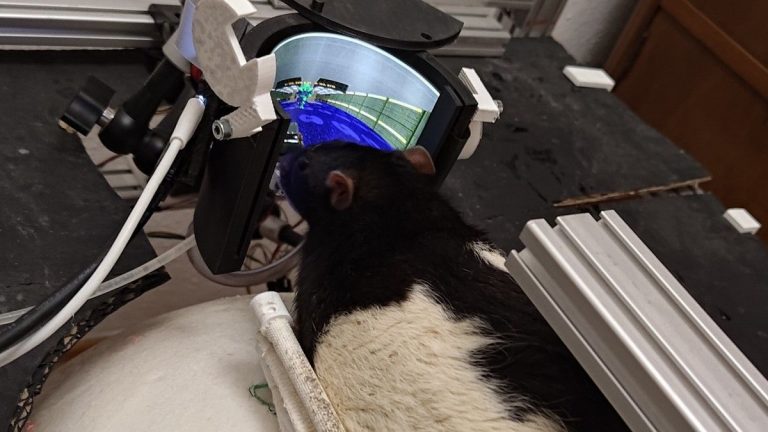The maker of our current pick for the best webcam, the Elgato Facecam MK2, has recently released a brand new Facecam. The Facecam Neo is aimed a little lower in the market than the MK2 and retails for $50 less at $99 USD. This can get cheaper if you bundle it, positioning the Facecam Neo as a hefty budget friendly contender.
As with the rest of the Neo range, the Facecam is packaged in a basic white recycled box. It comes with a matching monitor stand complete with transparent front lip for screens, and has a braided USB cable hardwired in. Pulling the pill shaped camera out of the box, the first two things I noticed were how light it feels, almost like empty plastic, and the mechanical notch for the privacy shutter.
Sadly, the shutter doesn’t feel satisfying to move. It is very easy to use and feels noticeably different when it’s in and out of place, so at least is unlikely to be in the wrong position accidentally. Plus, the cover slides in front of the lens, but behind the main housing, which should keep it safer during travel.
This camera is also completely devoid of a mic, which I think is excellent. Webcam mics are never good and are usually too far away to begin with. By not having a mic, Elgato has saved me a tonne of frustration, be it from my programs choosing it as the default mic, or having just another device listening in. No mic plus a privacy shutter means you can leave this cam plugged in and don’t have to worry about yet another digital spy or accidental embarrassment. Plus the LED is large and remains on whenever the camera is active.
(Image credit: Future)
Supported resolutions: 1080p60, 1080p30 HDR, 720p60, 720p30, 540p60, 540p30
Optics: Elgato AF Lens
Focus: Fixed (30 – infinite)
Field of view: 77°
Sensor: CMOS sensor 1/2.9-inch
Connection: USB Type-C
Dimensions: 88 x 32 x 40 mm
Price: $100 USD | £100 | $170 AUD
All in all, It’s a huge step up from a tab of electrical tape over the lens.
The Elgato Facecam Neo pumps out 1080p at up to 60 fps making it more than enough for most streams and meetings. It’s not the best choice for video with those specs but still does well.
For a light little webcam that can fit easily into most settings it’s very capable. It does a great job of colours and skin tones but tends to lean just a little towards oversaturation, which ramps up when it tries to compensate for low light. I’ve plugged it into a few PCs with different software and it’s been seamless every time. However, you might want to grab Elgato’s free camera hub software to get access to all the features.
The hub has controls for many things, like zoom and brightness, which can be saved to the camera to then be used in other apps. Most of these I was able to leave on auto quite happily, but this was also the only way I could see to enable the much sought after HDR setting.
(Image credit: Future)
(Image credit: Future)
(Image credit: Future)
(Image credit: Future)
Enabling HDR will restrict you from 60 fps to just 30, but will make a huge difference if you’ve got bright lights like windows messing up your shot. I can have a bright window behind me and still be nice and clear as opposed to creepy shadow creature. I just wouldn’t recommend using it in all scenarios.
As well as losing out on those 30 frames, I found at my well lit desk, turning HDR on didn’t look any different and would really mess with the autofocus. The focus became very sluggish and sometimes would be stuck at a blur, unable to focus at all. The autofocus isn’t particularly snappy, generally speaking, which has bothered me occasionally, but it at least usually gets there within a few seconds max, and then holds it well until drastic changes.
Thankfully, with HDR on and a big window behind me, more like what it’s designed for, I didn’t have this issue. So in that sense it’s not really a problem but does raise some questions about the autofocus. There are also options to turn the focus from auto to fixed in the software, which might be a workaround if you need it. Unfortunately, all of this means you might actually need the Elgato camera hub to make changes. Being able to save settings to the camera is a huge help here, but it makes me wish it had profiles, or even just a button for toggling HDR. The good news is the app is free and easy to use, so this shouldn’t be a huge barrier.
(Image credit: Future)
(Image credit: Future)
(Image credit: Future)
✅ You’re after a simple plug and play camera that is easy to travel with: Not only is it lightweight and small, I’ve tried this on PCs, laptops, and even my iPad and it just immediately works. Plus, using HDR enables it to thrive with awkwardly backlit environments.
✅ You specifically have to contend with bad window lighting and want a reasonably priced HDR camera: If your desk setup is permanently backlit by a window and you want a reliable camera that can handle it, the Facecam Neo has you covered.
❌ You’ve got a really well lit desk setup: Something with a snappier autofocus or higher resolution might be a better choice here, depending on the budget.
While wonderfully versatile, if you’re wanting a dedicated webcam to hangout at your already well lit station, the Facecam Neo may not be the best choice. You could swap out some of that versatility and go for something with a fixed focus made for desks, and a better sensor that might deliver a higher quality image, like the Elgato Facecam MK2. Or even go for something fancier and 4K if you wanted to make videos as well. This isn’t necessarily the webcam I’d recommend first for a single, already well lit, desk setup.
Instead, this is a camera that will work fairly well even if you are plagued with horrible light. It only takes a few tweaks to have it working well at a purposely lit streamer’s desk as it does to have it in an awkward office. It’s lightweight, small, works immediately with all the software I’ve tried it on (including FaceTime on my iPad), and without also trying to be a mic. Plus, 1080p at 30 – 60 fps is still more than enough for streaming and video calls.
Those are some pretty big wins, especially for under $100 USD. It all comes together to make the Facecam Neo a smart choice, especially if you’ve got harsh light or use this cam on different setups easily.












